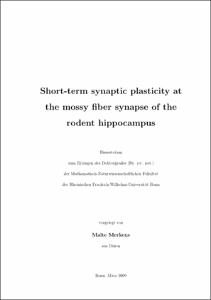Short-term synaptic plasticity at the mossy fiber synapse of the rodent hippocampus

Short-term synaptic plasticity at the mossy fiber synapse of the rodent hippocampus

| dc.contributor.advisor | Beck, Heinz | |
| dc.contributor.author | Merkens, Malte | |
| dc.date.accessioned | 2020-04-14T03:12:19Z | |
| dc.date.available | 2020-04-14T03:12:19Z | |
| dc.date.issued | 08.10.2009 | |
| dc.identifier.uri | https://hdl.handle.net/20.500.11811/4137 | |
| dc.description.abstract | Synaptic short- and long-term plasticity are key mechanisms by which neuronal ensembles store information. The mossy fiber synapse (MF-CA3 synapse) is formed by axons of dentate gyrus granule cells and exhibits a striking form of short-term plasticity that is distinct from most other synapses in the CNS. Stimulation of mossyfiber axons at low frequencies (0.1 - 10 Hz) causes a dramatic increase in glutamate release at the MF-CA3 synapse, and a concomitant augmentation of the excitatory postsynaptic potentials. This phenomenon is called frequency facilitation. The mechanisms of frequency facilitation are currently under discussion. We therefore tested the role of Ca2+ in the mediation of frequency facilitation at MF-CA3 synapses and found frequency facilitation independent of an accumulation of bulk Ca2+. We tested the effect of blocking N- and P/Q-type voltage gated Ca2+ channels on frequency facilitation and found both channels contributing equally to the expression of frequency facilitiaton. Because of the complex behavior of frequency facilitation from the extracellular Ca2+ concentration, we tested different mathematical models to explain this form of plasticity. A model with two distinct Ca2+ sensors, one responsible for basal transmitter release while the other one causes facilitation of release, described best our data. We furthermore tested the role of different signalling pathways that are known to affect transmitter release and other forms short-term plasticity. Facilitation was unaltered in mice lacking functional αCamKII, or following application of CamKII blockers. It was also unaffected by inhibition of protein kinase A (PKA), protein kinase C (PKC), mitogen-activated protein kinase (MAPK), phosphatases, Kainate receptors (KARs), phosphatidyl-inositol kinase 3 and 4 (PI-3 and PI-4 kinase), and agents affecting the integrity of the cytoskeleton. These data suggest that frequency facilitation is either mediated by signalling cascades that are distinct from the ones tested in this study, or alternatively, they are consistent with a more direct Ca2+-dependent mechanism acting directly on the release machinery. | |
| dc.language.iso | eng | |
| dc.rights | In Copyright | |
| dc.rights.uri | http://rightsstatements.org/vocab/InC/1.0/ | |
| dc.subject | Hippocampus | |
| dc.subject | synaptische Plastizität | |
| dc.subject | Moosfaser | |
| dc.subject.ddc | 570 Biowissenschaften, Biologie | |
| dc.title | Short-term synaptic plasticity at the mossy fiber synapse of the rodent hippocampus | |
| dc.type | Dissertation oder Habilitation | |
| dc.publisher.name | Universitäts- und Landesbibliothek Bonn | |
| dc.publisher.location | Bonn | |
| dc.rights.accessRights | openAccess | |
| dc.identifier.urn | https://nbn-resolving.org/urn:nbn:de:hbz:5N-18802 | |
| ulbbn.pubtype | Erstveröffentlichung | |
| ulbbnediss.affiliation.name | Rheinische Friedrich-Wilhelms-Universität Bonn | |
| ulbbnediss.affiliation.location | Bonn | |
| ulbbnediss.thesis.level | Dissertation | |
| ulbbnediss.dissID | 1880 | |
| ulbbnediss.date.accepted | 14.07.2009 | |
| ulbbnediss.institute | Medizinische Fakultät / Kliniken : Klinik für Epileptologie | |
| ulbbnediss.fakultaet | Mathematisch-Naturwissenschaftliche Fakultät | |
| dc.contributor.coReferee | Bleckmann, Horst |
Files in this item
This item appears in the following Collection(s)
-
E-Dissertationen (4077)




